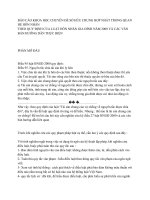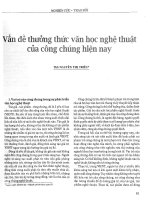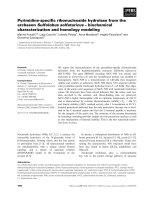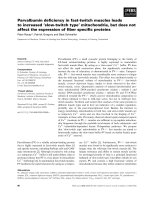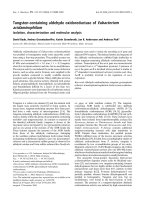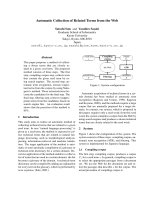Báo cáo khoa học: Sulfide : quinone oxidoreductase (SQR) from the lugworm Arenicola marina shows cyanide- and thioredoxin-dependent activity pdf
Bạn đang xem bản rút gọn của tài liệu. Xem và tải ngay bản đầy đủ của tài liệu tại đây (531.54 KB, 9 trang )
Sulfide : quinone oxidoreductase (SQR) from the
lugworm Arenicola marina shows cyanide- and
thioredoxin-dependent activity
Ursula Theissen and William Martin
Institute of Botany III, University of Duesseldorf, Germany
The sulfide tolerance of marine invertebrates, such as
the lugworm Arenicola marina, has been studied for
many years. The animals live in marine sediments in
which sulfide concentrations can sometimes reach up
to 2 mm [1–3]. Sulfide is a potent toxin for humans
and most animals because it inhibits mitochondrial
cytochrome c oxidase at micromolar concentrations
[4]. Lugworms and other marine invertebrates, such as
the ribbed mussel Geukensia demissa, are sulfide toler-
ant [5], however, and can even use electrons from
sulfide for mitochondrial ATP production [6]. The
electrons are transferred to ubiquinone and, under
normoxic conditions, sulfide is oxidized to thiosulfate
in the mitochondria [7,8]. An enzyme similar to bacte-
rial sulfide:quinone oxidoreductase (SQR) has been
postulated to be involved in the transfer of electrons
from sulfide to ubiquinone during thiosulfate forma-
tion in the mitochondria of A. marina [5].
Bacterial SQR is a membrane-bound flavoprotein
that catalyzes the reaction H
2
S + Ubiquinone fi
[S
±0
] + UbiquinoneH
2
[9]. The enzyme has an appar-
ent molecular mass of 48–55 kDa and high affinities
for the substrates sulfide and quinone, with K
m
values
in the range 2–32 lm [9]. It belongs to the glutathione
reductase family of flavoproteins and is inhibited by
quinone analogs (e.g. antimycin A) at micromolar or
nanomolar concentrations [10].
Although biochemical evidence for mitochondrial
SQR has been shown for several eukaryotes, including
the mollusc G. demissa [11] and chicken mitochondria
Keywords
cyanide; mitochondria; sulfide;
sulfide : quinone oxidoreductase (SQR);
thioredoxin
Correspondence
W. Martin, Institute of Botany III,
Heinrich-Heine University of Duesseldorf,
Universitaetsstrasse 1, 40225 Duesseldorf,
Germany
Fax: +49 211 811 3554
Tel: +49 211 811 3011
E-mail:
Database
The nucleotide sequence reported is avail-
able in the DDBJ ⁄ EMBL ⁄ GenBank database
under the accession number EF656452
(Received 24 October 2007, revised 17
December 2007, accepted 7 January 2008)
doi:10.1111/j.1742-4658.2008.06273.x
The lugworm Arenicola marina inhabits marine sediments in which sulfide
concentrations can reach up to 2 mm. Although sulfide is a potent toxin
for humans and most animals, because it inhibits mitochondrial cyto-
chrome c oxidase at micromolar concentrations, A. marina can use elec-
trons from sulfide for mitochondrial ATP production. In bacteria, electron
transfer from sulfide to quinone is catalyzed by the membrane-bound flavo-
protein sulfide : quinone oxidoreductase (SQR). A cDNA from A. marina
was isolated and expressed in Saccharomyces cerevisiae, which lacks endo-
genous SQR. The heterologous enzyme was active in mitochondrial
membranes. After affinity purification, Arenicola SQR isolated from yeast
mitochondria reduced decyl-ubiquinone (K
m
= 6.4 lm) after the addition
of sulfide (K
m
=23lm) only in the presence of cyanide (K
m
= 2.6 mm).
The end product of the reaction was thiocyanate. When cyanide was substi-
tuted by Escherichia coli thioredoxin and sulfite, SQR exhibited one-tenth
of the cyanide-dependent activity. Six amino acids known to be essential
for bacterial SQR were exchanged by site-directed mutagenesis. None of
the mutant enzymes was active after expression in yeast, implicating these
amino acids in the catalytic mechanism of the eukaryotic enzyme.
Abbreviations
Ni-NTA, nickel nitrilotriacetic acid; SQR, sulfide : quinone oxidoreductase.
FEBS Journal 275 (2008) 1131–1139 ª 2008 The Authors Journal compilation ª 2008 FEBS 1131
[12], the corresponding DNA sequences or purified
protein are lacking. A functional mitochondrial SQR
that promotes electron transfer from sulfide to quinone
was cloned and characterized from the fission yeast
Schizosaccharomyces pombe, but the enzyme had very
low affinities for sulfide and quinone, with K
m
values
of 2 mm for both substrates. However, the S. pombe
SQR showed marked sequence similarity to the bacte-
rial SQR purified and characterized at the biochemical
level from Rhodobacter capsulatus [13].
Sulfide : quinone oxidoreductase homologs have
subsequently been reported in the genomes of many
prokaryotes and eukaryotes, including fungi, insects
and mammals [14]. Three distinct groups of sequence
diversity (groups I, II and III) have been identified.
Five SQR fingerprints have been identified for SQR
bacterial group I. Three of these fingerprint domains,
including two cysteines and the FAD-binding domai-
n III, are conserved amongst all SQR sequences [14].
Sulfide : quinone oxidoreductase was probably an
essential and ubiquitous enzyme during the phase of
eukaryotic evolution 1–2 billion years ago, because the
Earth’s ocean waters were anoxic and sulfidic during
that time [15–17]. Even today, SQR is an important
enzyme for many animals, because sulfide is produced
endogenously in several tissues of mammals [18–20]
and marine invertebrates [21]; in humans, the overpro-
duction of sulfide can lead to disease [22]. However,
from the standpoint of environmental ecology, modern
sulfide-tolerant animals, such as Arenicola, require an
enzyme for efficient sulfide oxidation. In this article,
we report the isolation of an sqr gene from the sulfide-
adapted, sand-dwelling marine worm A. marina, its
heterologous expression in Saccharomyces cerevisiae,
its kinetic parameters, and the identification of catalyt-
ically critical active residues through site-directed
mutagenesis.
Results
SQR cDNA from A. marina is expressed in the
yeast mitochondrial membrane
Screening of recombinant phages in an A. marina
cDNA library with a heterologous probe for the SQR
homolog encoded in the Drosophila genome [14]
yielded two independent clones of different length.
Clone A22-1 contained a full-length cDNA and was
3317 bp long with an ORF of 1377 bp, encoding a
protein of 458 amino acid residues (see Fig. 1) with
35% amino acid identity to S. pombe SQR (accession
no. NP_596067) and 23% amino acid identity to
SQR from R. capsulatus (accession no. CAA66112).
Expression of the A22-1 ORF in Escherichia coli
yielded no active SQR enzyme (data not shown);
hence, it was cloned into the yeast expression vector
pYES2 ⁄ CT and transformed into INVSc1 yeast cells,
whose SQR expression was induced with 20% galac-
tose. SQR was expressed in the mitochondrial mem-
branes of the yeast, as shown by immunodetection of
the His tag (Fig. 2). Mitochondria isolated from yeast
cells carrying pYES2⁄ CT + SQR specifically reduced
decyl-ubiquinone after the addition of sulfide. Cyto-
chrome c oxidase was inhibited by cyanide to avoid
the re-oxidation of ubiquinone. Mitochondria isolated
from yeast cells carrying the empty expression vector
did not reduce ubiquinone after the addition of sulfide.
Using 0.5% Triton X-100, SQR was solubilized from
the mitochondrial membranes and purified by nickel
nitrilotriacetic acid (Ni-NTA) chromatography. The
fractions after purification showed some contaminating
proteins (Fig. 2), but, as a result of the low yield and
stability of the expressed protein, no further purifica-
tion steps were applied.
Cyanide-dependent catalytic properties of
recombinant SQR
The kinetic parameters of Arenicola SQR were deter-
mined using the pooled and concentrated fractions
after Ni-NTA chromatography. It was observed that
isolated membranes and isolated SQR were active only
in the presence of millimolar concentrations of cya-
nide, which initially had been introduced to inhibit
decyl-ubiquinoneH
2
re-oxidation, but was later found
to be required for SQR-dependent decyl-ubiquinone
reduction in the absence of thioredoxin and sulfite
Fig. 1. Sequence of SQR from Arenicola marina. The deduced
amino acid sequence is shown; the predicted mitochondrial transit
peptide of 80 amino acids is shaded in grey. The amino acids
shown in bold were exchanged by site-directed mutagenesis. The
three conserved SQR fingerprint regions are underlined.
Thioredoxin-dependent activity of lugworm SQR U. Theissen and W. Martin
1132 FEBS Journal 275 (2008) 1131–1139 ª 2008 The Authors Journal compilation ª 2008 FEBS
(see below). For this reason, 2 mm cyanide was
included in the reaction mixture. In the cyanide-depen-
dent reaction, the K
m
value for decyl-ubiquinone was
6.4 lm; the K
m
value for sulfide of 23 lm was obtained
using correction for uncompetitive substrate inhibition,
with the corresponding inhibitor concentration yielding
half-maximal reaction rate (K
i
) determined as 480 lm
(Fig. 3). The specific activity varied between 1.5 and
5.6 lmolÆmin
)1
Æmg
)1
. Cyanide concentrations up to
20 mm were tested; the K
m
value for cyanide was
2.6 mm and the K
i
value for substrate inhibition was
0.7 mm (data fitted to the Michaelis–Menten equation
corrected for uncompetitive substrate inhibition). The
cyanide-dependent SQR reaction had an optimum of
pH 9 (Fig. 4). The quinone analog antimycin A inhib-
ited the SQR reaction; the inhibition had a competitive
component, as the K
m
value for decyl-ubiquinone was
elevated to 8 lm in the presence of 10 lm antimycin A,
and to 13 lm in the presence of 50 lm antimycin A
(Fig. 5).
Fig. 2. 12% SDS-PAGE after silver staining (lanes 1–5) and western blot analysis with immunodetection of the His tag. Detection was
carried out with anti-His IgG (monoclonal mouse IgG, Novagen, Nottingham, UK). Anti-mouse secondary IgG horseradish peroxidase
conjugate from goat was used. Ten micrograms of protein were used from fractions of an SQR ⁄ His purification from a 4 L culture of
Saccharomyces cerevisiae INVSc1 carrying pYES2Ct + SQR. Lane 1, size marker; lane 2, mitochondria; lane 3, mitochondrial membranes;
lane 4, SQR ⁄ His after one Ni-NTA chromatographic run; lane 5, SQR ⁄ His after two Ni-NTA chromatographic runs; lane 6, post-mitochondrial
supernatant; lane 7, mitochondria; lane 8, soluble mitochondrial proteins; lane 9, mitochondrial membranes; lane 10, SQR ⁄ His after Ni-NTA
chromatography. Arrows indicate the SQR ⁄ His bands at 50 kDa.
Fig. 3. Affinity of SQR ⁄ His for sulfide in the presence of cyanide or thioredoxin. Left: Michaelis–Menten plot corrected for uncompetitive
substrate inhibition for sulfide affinity of SQR ⁄ His in the presence of cyanide (K
m
= 22.9 lM; K
i
= 480 lM; V
max
= 5.3 lmolÆmin
)1
Æmg
)1
).
Right: Michaelis–Menten plot corrected for uncompetitive substrate inhibition for sulfide affinity of SQR ⁄ His in the presence of thioredoxin
and sulfite (K
m
= 23.3 lM; K
i
= 3.8 lM; V
max
= 0.66 lmolÆmin
)1
Æmg
)1
). For plotting, the Enzyme Kinetics Module of the program SIGMA PLOT
9.0 (Jandel Scientific, San Rafael, CA, USA) was used. n =3.
U. Theissen and W. Martin Thioredoxin-dependent activity of lugworm SQR
FEBS Journal 275 (2008) 1131–1139 ª 2008 The Authors Journal compilation ª 2008 FEBS 1133
The product of the SQR reaction in the presence
of cyanide is not thiosulfate, but thiocyanate
Thiosulfate and sulfite were not detected in greater
amounts in assay mixtures with SQR than in control
mixtures without enzyme. However, thiocyanate was
detected as a product of the reaction. In the presence
of 100 lm decyl-ubiquinone, 43 ± 7 nmol thiocyanate
was detected after 65 min. In the presence of 200 lm
decyl-ubiquinone, the concentration of thiocyanate
increased to 60 ± 5 nmol after 5 min of incubation.
Arenicola SQR shows a thioredoxin-dependent
activity
Cyanide has been described as an in vitro substrate for
rhodanese (E.C. 2.8.1.1) [23,24]. Rhodanese is also
active if thioredoxin is used instead of cyanide [25,26].
Therefore, we tested thioredoxin as a cosubstrate for
Arenicola SQR in the presence of 15 lm thioredoxin
(reduced by thioredoxin reductase) and millimolar con-
centrations of sulfite. Sulfite was introduced because
Arenicola mitochondria are known to produce thiosul-
fate from sulfide [7]. The K
m
value for sulfide in the
presence of thioredoxin and sulfite was 23 lm with a
V
max
value of 0.66 lmolÆmin
)1
Æmg
)1
. The K
i
value for
substrate inhibition was 3.8 lm.
Three SQR fingerprints were found in Arenicola
SQR
In eukaryotic SQR sequences, three of five SQR finger-
prints identified by Griesbeck et al. [9] were conserved
[14]. These fingerprints were also found in Arenicola
SQR. Phylogenetic analysis of SQR sequences revealed
three groups of sequence diversity [13], with group II
representing all eukaryotic sequences. Arenicola SQR
is a member of this group (data not shown).
Site-directed mutagenesis of six conserved
amino acids in eukaryotic SQRs leads to a loss of
activity for each mutated protein
In separate constructs, the two cysteine residues
Cys208 and Cys386 were replaced with serine, the his-
tidine residues His86 and His299, and Glu159, with
alanine, and Asp342 with valine. All mutated proteins
were expressed in the mitochondrial membrane of
yeast, but none of the proteins showed detectable
activity, in contrast with the A22-1 control.
Discussion
The first eukaryotic SQR was described for the fission
yeast S. pombe [27]. As the K
m
values of the enzyme
for sulfide and quinone were in the millimolar range,
the in vivo function as an SQR remained contentious.
Recently, many homologs of S. pombe SQR have been
identified in other eukaryotic genomes [14], but none
of these has previously shown catalytic activity. Sul-
fide-detoxifying enzymes are essential for animals, such
as the lugworm A. marina, that are often exposed to
high sulfide concentrations in their habitats. Little is
yet known about the enzymes involved in mitochon-
drial sulfide oxidation, but biochemical evidence has
Fig. 4. pH dependence of SQR ⁄ His activity in the presence of cya-
nide. The activity relative to the maximal activity at the pH optimum
is shown in different buffers of varying pH. The maximum activity
at pH 9 was 5.6 lmolÆmin
)1
Æmg
)1
. Measurements were carried out
at 22 °C in the presence of 20 m
M buffer, 100 lM decyl-ubiquinone
and 2 m
M cyanide. The reaction was started with 200 lM sulfide.
n =3.
Fig. 5. Inhibition of SQR ⁄ His activity by antimycin A. Michaelis–
Menten plot of the specific activity of SQR ⁄ His (lmolÆmin
)1
Æmg
)1
)
at different concentrations of decyl-ubiquinone in the presence of
0, 10 and 50 l
M antimycin A. n =3.
Thioredoxin-dependent activity of lugworm SQR U. Theissen and W. Martin
1134 FEBS Journal 275 (2008) 1131–1139 ª 2008 The Authors Journal compilation ª 2008 FEBS
been reported for an SQR in the mitochondria of
lugworms [5,7].
The SQR from Arenicola is catalytically active
in the presence of cyanide
The enzyme was expressed in yeast mitochondrial
membranes and purified using Ni-NTA affinity chro-
matography. Decyl-ubiquinone was reduced after the
addition of sulfide, but only in the presence of cyanide.
This was surprising, because bacterial SQR requires no
additional substrate other than sulfide and quinone,
and, for the SQR from S. pombe, cyanide-independent
activity has been described [27]. However, the K
m
values for sulfide and quinone of 2 mm reported for
S. pombe SQR were orders of magnitude higher than
those reported for bacterial SQR, whose K
m
values
were in the range 2–8 lm (Table 1); accordingly, the
in vivo role of S. pombe SQR as a sulfide-oxidizing
enzyme was called into question [9]. In this study, we
aimed to characterize an SQR from a eukaryote,
A. marina, that encounters physiologically relevant
concentrations of sulfide in its natural environment.
Initially, cyanide was included in the reaction mixture
when intact mitochondria were measured to inhibit
cytochrome c oxidase and thus to avoid a re-oxidation
of ubiquinone. However, it was found that cyanide is
a cosubstrate for purified SQR with a K
m
value of
2.6 mm. These findings are supported by the recent
report of a cyanide-dependent increase in SQR activity
for the enzyme from Pseudomonas putida [28], which,
like A. marina SQR, belongs to the sequence group II
designated previously [14].
The end product of the cyanide-dependent reaction
is thiocyanate. The spectrophotometric detection of
thiocyanate is a general method for the quantification
of sulfane sulfur [29], as first described for rhodanese
[30,31], which catalyzes the sulfur transfer from thio-
sulfate to cyanide with the formation of thiocyanate
and sulfite in vitro. The physiological role and sub-
strates of rhodanese have long been debated, and vari-
ous roles have been suggested. It has been shown that
thioredoxin, instead of cyanide, can interact with
rhodanese [25,26].
Arenicola SQR interacts with thioredoxin
Cyanide is not usually produced endogenously in large
amounts by animals, and millimolar concentrations
cannot be found in the environment. Thus, cyanide is
probably not the in vivo cosubstrate of SQR. Thiore-
doxin was tested for its interaction with SQR. SQR
was active in the presence of thioredoxin, but only if
sulfite was added to the reaction mixture. This suggests
a more complex sulfide detoxification pathway, involv-
ing at least one more enzyme in addition to SQR.
SQR does not produce thiosulfate, it is a
persulfide donor
For bacterial SQR, the reaction mechanism has been
described [9]. Three conserved cysteines play an
essential role in the reductive half-reaction. As
eukaryotic SQR lacks a third cysteine [14], the
cysteine-bound persulfide must be transferred to an
external acceptor to enable the electron transfer on
FAD. This suggests a function of SQR as a persulfide
donor. Indeed, there have been reports of sulfane sul-
fur formation in the sipunculid Phascolosoma arcuatum
[32] and the mudskipper Boleophthalmus boddaerti [33]
under sulfidic and anaerobic conditions. A possible
mechanism of persulfide formation is shown in Fig. 6,
involving Cys208 and Cys387. Glu159 may play a role
as the active site base, in analogy with the bacterial
reaction [9]. The oxidative half-reaction of Arenicola
SQR may be similar to the proposed bacterial
oxidative reaction, involving two histidines for
acid–base catalysis [9].
Asp342 is required for Arenicola SQR function
The mutation of Asp342 to valine led to an inactive
SQR enzyme. The FAD-binding domain of all eukary-
otic SQRs, including A. marina SQR, contains a con-
served aspartate at position 342 (numbering according
to the Arenicola sequence; marked in bold in Fig. 1).
This is in contrast with bacterial SQRs, which possess
valine at this position [9,14]. Griesbeck et al. [9]
showed that an exchange of Val300 to Asp300 in Rho-
dobacter SQR reduced the activity to 11% of wild-type
activity. Changing the corresponding residues, Asp342
to Val342, in Arenicola SQR led to a total loss of
detectable activity. All members of the glutathione
reductase family, besides bacterial SQR, possess an
aspartate at this position, and crystallographic studies
for some of these enzymes have revealed a function in
binding the ribose subunit of FAD by Asp342 [34–36].
The exchange of Asp342 to Val342 in Arenicola SQR
Table 1. Comparison of mean K
m
values for sulfide, decyl-ubiqui-
none and cyanide of Arenicola marina, Schizosaccharomyces pom-
be [26] and Rhodobacter capsulatus [9] SQR.
K
m
sulfide K
m
ubiquinone K
m
cyanide
A. marina 23 l
M 6.4 lM 2.6 mM
S. pombe 2mM 2mM Not determined
R. capsulatus 2 l
M 2 lM Inhibitor
U. Theissen and W. Martin Thioredoxin-dependent activity of lugworm SQR
FEBS Journal 275 (2008) 1131–1139 ª 2008 The Authors Journal compilation ª 2008 FEBS 1135
might affect FAD binding, although a loss of SQR
activity as a result of misfolding of the mutant enzyme
cannot currently be excluded.
The physiological role of mitochondrial SQR in
lugworms and higher eukaryotes
Animals inhabiting sulfide-rich environments require
powerful mechanisms to detoxify sulfide. However,
SQR homologs can be found in most, but not all, ani-
mal genomes. As a relict of the sulfidic and anoxic
phase of the Earth’s history, when all marine organ-
isms had to deal with high environmental sulfide con-
centrations [15–17], SQR might have played a role. In
eukaryotes that do not today inhabit sulfidic environ-
ments, sulfide has been discussed as a modulator of
physiological responses and an atypical neuromodula-
tor, in addition to the gases NO and CO [37]. Endoge-
nous sulfide production has been described, not only
for marine invertebrates, such as A. marina and the
mussel Tapes philippinarum [21], that deal with high
environmental concentrations of sulfide daily, but also
for various mammals that do not [18–20].
Starting from l-cysteine, endogenous sulfide can
be synthesized in at least four different ways [38]. In
mitochondria, cysteine-aminotransferase (E.C. 2.6.1.3)
and 3-mercapto-sulfurtransferase (E.C. 2.8.1.2) can
be involved in sulfide production [38]. Cysteine-amino-
transferase catalyzes the reaction of l-cysteine with a
ketoacid (e.g. a-ketoglutarate), with the formation
of 3-mercaptopyruvate and an amino acid (e.g.
l-glutamate). 3-Mercaptopyruvate is desulfurated by
3-mercaptopyruvate-sulfurtransferase, resulting in the
formation of sulfide and pyruvate [21]. In the cytosol,
sulfide can be generated by cystathione-b-synthase
(E.C. 4.2.1.22). Alongside endogenous sulfide produc-
tion in mammals, considerable amounts of sulfide can
be produced by anaerobic sulfate-reducing bacteria in
the human colon, posing a challenge to cells of the
intestinal epithelium [39].
Such findings suggest that even animals that are not
exposed to environmental sulfide require biochemical
means of dealing with sulfide, albeit at lower concentra-
tions than those experienced by sulfide-exposed marine
invertebrates. A failure to deal with endogenous sulfide
can have dire consequences in humans. For example,
the overproduction of sulfide as a result of enhanced
cystathione-b-synthase activity can exacerbate cognitive
effects in Down’s syndrome patients [22,40], and insuf-
ficient detoxification of sulfide produced in the human
colon can lead to inflammatory diseases and may affect
the frequency of colon cancer [41]. Whether or not
SQR plays a significant physiological role in mamma-
lian sulfide metabolism remains to be shown.
Materials and methods
Yeast growth conditions
INVSc1 cells (Invitrogen, Carlsbad, CA, USA) were grown
at 30 °C in SC minimal medium (0.67% yeast nitrogen base
without amino acids, 2% glucose, drop-out medium with-
out uracil). Protein expression was induced by replacing
glucose with galactose (2%) and raffinose (1%).
Fig. 6. Proposed mechanism of persulfide formation in the reductive half-reaction of SQR with thioredoxin or cyanide as cosubstrate. Sulfide
cleaves the disulfide bond between Cys208 and Cys387 and a persulfide at one of the cysteines is formed. In bacteria, a third cysteine is
involved in releasing the persulfide [8]. As Arenicola SQR lacks this cysteine, the sulfane sulfur is transferred to an external acceptor, such
as thioredoxin or the nonphysiological acceptor cyanide (dotted arrows). The active site base Glu159 removes a proton from the second cys-
teine and a thiolate is formed. This negative charge is transferred to FAD (based on and modified from [8]).
Thioredoxin-dependent activity of lugworm SQR U. Theissen and W. Martin
1136 FEBS Journal 275 (2008) 1131–1139 ª 2008 The Authors Journal compilation ª 2008 FEBS
RNA isolation and cDNA synthesis
RNA was isolated from approximately 10 g of body wall
tissue of A. marina collected from the Dutch coast. For
mRNA isolation, the mRNA Purification Kit (GE Health-
care Biosciences, Uppsala, Sweden) was used. cDNA was
synthesized using the Time Saver cDNA Synthesis Kit (GE
Healthcare Biosciences). Total RNA from Drosophila was
isolated using the Nucleospin RNA II Kit (Macherey-
Nagel, Dueren, Germany). For cDNA synthesis, the first-
strand synthesis kit for RT-PCR (Invitrogen) was used.
Hybridization probe, cloning and heterologous
expression
Standard molecular and biochemical methods, cDNA syn-
thesis and cloning in kZAPII were performed as described
previously [42]. Drosophila melanogaster SQR (NP_647877)
was amplified using 5¢-ATGAACCGTCGCCTTCCAGG
AACC-3¢ and 5¢-GCACTGAGAAAATTTTCCGCATT
AGTGCC-3¢ as primers. DNA was sequenced by the
Sanger didesoxy method [43]. For heterologous expression
of A. marina SQR in S. cerevisiae, the shuttle vector
pYES2 ⁄ CT (Invitrogen) with a C-terminal His tag was
used. SQR was cloned into the HindIII ⁄ XbaI site.
Site-directed mutagenesis
The following primers were designed using the program ‘the
primer generator’ ( />primer/primer.cgi [44]): Asp342Val, 5¢-GTCTTCGGCATC
GGTGTCAACACGGATATACCG-3¢ and 3¢-CAGAAGC
CGTAGCCACAGTTGTGCCTATATGGC-5¢; Cys208Ser,
5¢-GCCCATCAAATCTGCAGGCGCGCCGC-3¢ and
3¢-CGGGTAGTTTAGACGTCCGCGCGGCG-5¢; Cys386-
Ser, 5¢-CGGCTACACGTCTTCCCCCCTGGTGACG-3¢
and 3¢-GCCGATGTGCAGAAGGGGGGACCACTGC-5¢;
His86Ala, 5¢-GCCGACACGGCCTACTATCAG-3¢ and
3¢-CGGCTGTGCCGGATGATAGTC-5¢; His299Ala,
5¢-GCCATGCTGGCCGTGGTGCCT-3¢ and 3¢-CGGTAC
GACCGGCACCACGGA-5¢; Glu59Ala, 5¢-GGGCTGCCT
GCAGCCTTC-3¢ and 3¢-CCCGACGGACGTCGGAAG-5¢;
nucleotides modified from the wild-type sequence are shown
in italic type. PCR was performed as described previously
[45]. Mutated SQRs were cloned into pYES2 ⁄ CT and
expressed in INVSc1.
Isolation of yeast mitochondria
S. cerevisiae carrying pYES2 ⁄ CT + SQR was grown at
30 °C for 24 h. The cells were harvested by centrifugation
(5 min, 1000 g)at20°C. The cells were washed with H
2
O,
followed by a washing step with washing buffer (20 mm
Tris ⁄ HCl, pH 7.4, 50 mm NaCl, 0.6 m sorbitol). The cell
pellet was resuspended in 30 mL of washing buffer
containing Yeast ⁄ Fungal Protease Inhibitor Cocktail
(Sigma, St Louis, MO, USA), and incubated on ice for
5 min. The cells were broken by rigorous vortexing for
3 · 1 min at 4 °C. Unbroken cells and cell debris were
centrifuged at 800 g at 4 °C for 5 min. The supernatant
was centrifuged for 20 min at 10 000 g at 4 °C. The pellet
(mitochondria) was resuspended in 20 mL of washing
buffer containing protease inhibitor.
Purification of SQR ⁄ His
Isolated mitochondria were broken by sonication. Mem-
branes were isolated by 1 h of ultracentrifugation at
30 000 r.p.m. (Sorvall Ultra Pro 80, rotor T-865). The pel-
let was resuspended in 5 mL of solubilization buffer
(50 mm NaP
i
, pH 7.2, 5% glycerol, 320 mm NaCl, 0.5%
Triton X-100) and stirred on ice for 1 h. The suspension
was loaded on a 1 mL Ni-NTA (Qiagen, Hilden, Germany)
column, and SQR was eluted with an imidazole gradient
using an FPLC system (GE Healthcare Biosciences). Frac-
tions containing activity were pooled and concentrated to
1 mL using Amicon Ultra-15 centrifugal filter devices
(Millipore, Billerica, MA, USA).
SQR activity assay
In the cyanide-dependent activity assay, SQR activity was
measured under air at room temperature. A 1 mL reaction
contained 20 mm Tris ⁄ HCl, pH 8.0, 100 lm decyl-ubiqui-
none (Sigma), 2 mm KCN and either isolated mitochon-
dria, membranes or purified enzyme. The reaction was
started with 200 lm sulfide (prepared freshly with
N
2
-flushed H
2
O) and the decrease in absorption at 275 nm
was followed for 3 min (modified from [27] and [46]). An
extinction coefficient of 15 LÆmmol
)1
Æcm
)1
for decyl-ubiqui-
none was used [47].
In the thioredoxin-dependent activity assay, a 1-mL
reaction contained 50 mm potassium phosphate, pH 8.2,
100 lm decyl-ubiquinone, 20 mm sulfite (prepared freshly
with N
2
-flushed H
2
O), 15 lm thioredoxin (from E. coli,
Sigma), 0.2 U thioredoxin-reductase (from E. coli, Sigma),
1mm NADPH and either isolated mitochondria, mem-
branes or purified enzyme. The reaction was started with
sulfide and the decrease in absorption at 275 nm was
followed for 5–10 min.
Determination of pH optimum and inhibition
studies
The pH optimum of the cyanide-dependent SQR reaction
was determined using sodium phosphate, Tris, Caps, Bicine,
and Hepes, covering a pH range from 5.8 to 11.1. Measure-
ments were carried out at 22.5 °C. Antimycin A (Sigma)
was used for inhibition studies at 10 and 50 lm.
U. Theissen and W. Martin Thioredoxin-dependent activity of lugworm SQR
FEBS Journal 275 (2008) 1131–1139 ª 2008 The Authors Journal compilation ª 2008 FEBS 1137
Determination of end products
Sulfide, sulfite and thiosulfate were determined by HPLC
using the bromobimane method modified from [48] and
[49]. Thiocyanate was determined as described previously
[23,30,31].
Phylogenetic network and fingerprint analysis
A phylogenetic network and fingerprint analysis of SQR
sequences, including Arenicola SQR, was performed as
described previously [14].
Determination of kinetic constants
Kinetic parameters were determined using nonlinear least-
square analysis of the data fitted to the Michaelis–Menten
rate equation (v = V
max
[S] ⁄ K
m
+[S]) or, where indicated,
the Michaelis–Menten equation corrected for uncompetitive
substrate inhibition [v = V
max
[S] ⁄ K
m
+[S](1 + [S] ⁄ K
i
)],
where v is the velocity, V
max
is the maximum velocity, S is
the substrate concentration, K
m
is the Michaelis–Menten
constant and K
i
is the inhibition constant, using sigma-
plot 9.0 (Systat Software, Erkrath, Germany) and the
enzyme kinetic module 2.0.
Acknowledgements
We thank the Deutsche Forschungsgemeinschaft for
financial support. UT received a stipend from the
DFG-Graduiertenkolleg ‘Molekulare Physiologie:
Stoff- und Energieumwandlung’. We thank Claudia
Kirberich for technical assistance and Manfred Gries-
haber and coworkers for discussions.
References
1 Fenchel TM & Riedl RJ (1970) The sulfide system: a
new biotic community underneath the oxidized layer of
marine sand bottoms. Mar Biol 7, 255–268.
2Vo
¨
lkel S & Grieshaber MK (1992) Mechanisms of
sulfide tolerance in the peanut worm Sipunculus nudus
(Sipunculida) and in the lugworm Arenicola marina
(Polychaeta). J Comp Physiol B 162, 469–477.
3Vo
¨
lkel S, Hauschild K & Grieshaber MK (1995)
Sulfide stress and tolerance in the lugworm Arenicola
marina during low tide. Mar Ecol Prog Ser 122, 205–
215.
4 Nicholls P (1975) The effect of sulfide on cytochrome
aa3. Isosteric and allosteric shifts of the reduced a-peak.
Biochim Biophys Acta 396, 24–35.
5Vo
¨
lkel S & Grieshaber MK (1997) Sulphide oxidation
and oxidative phosphorylation in the mitochondria of
the lugworm Arenicola marina. J Exp Biol 200, 83–92.
6 Doeller JE, Grieshaber MK & Kraus DW (2001)
Chemolithoheterotrophy in a metazoan tissue: thiosul-
fate production matches ATP demand in ciliated mussel
gills. J Exp Biol 204, 3755–3764.
7Vo
¨
lkel S & Grieshaber MK (1996) Mitochondrial
sulfide oxidation in Arenicola marina: evidence for alter-
native electron pathways. Eur J Biochem 235, 231–237.
8 Wohlgemuth SE, Taylor AC & Grieshaber MK (2000)
Ventilatory and metabolic responses to hypoxia and sul-
phide in the lugworm Arenicola marina (L.). J Exp Biol
203, 3177–3188.
9 Griesbeck C, Schu
¨
tz M, Scho
¨
dl T, Bathe S, Nausch L,
Mederer N, Vielreicher M & Hauska G (2002) Mecha-
nism of sulfide-quinone reductase investigated using
site-directed mutagenesis and sulfur analysis. Biochemis-
try 41, 11552–11565.
10 Griesbeck C, Hauska G & Schu
¨
tz M (2000) Biological
sulfide-oxidation: sulfide-quinone reductase (SQR), the
primary reaction. In Recent Research Developments in
Microbiology Vol. 4 (Pandalai SG, ed.), pp. 179–203.
Research Signpost, Trivadrum, India.
11 Doeller JE, Gaschen BK, Parrino VV & Kraus DW
(1999) Chemolithoheterotrophy in a metazoan tissue:
sulfide supports cellular work in ciliated mussel gills.
J Exp Biol 202, 1953–1961.
12 Yong R & Searcy DG (2001) Sulfide oxidation coupled
to ATP synthesis in chicken liver mitochondria. Comp
Biochem Physiol B 129, 129–137.
13 Schu
¨
tz M, Shahak Y, Padan E & Hauska G (1997)
Sulfide quinone reductase from Rhodobacter capsulatus.
J Biol Chem 272
, 9890–9894.
14 Theissen U, Hoffmeister M, Grieshaber M & Martin
W (2003) Single eubacterial origin of eukaryotic
sulfide:quinone oxidoreductase, a mitochondrial
enzyme conserved from the early evolution of eukary-
otes during anoxic and sulfidic times. Mol Biol Evol
20, 1564–1574.
15 Canfield DE (1998) A new model for Proterozoic ocean
chemistry. Nature 396, 450–453.
16 Shen Y, Buick R & Canfield DE (2001) Isotopic
evidence for microbial sulphate reduction in the early
Archean era. Nature 410, 77–81.
17 Anbar AD & Knoll AH (2002) Proterozoic ocean chem-
istry and evolution: a bioinorganic bridge. Science 297,
1137–1142.
18 Goodwin LR, Francom D, Dieken FP, Taylor JD,
Warenycia NW, Reiffenstein RJ & Dowling G (1989)
Determination of sulfide in brain tissue by gas dialy-
sis ⁄ ion chromatography: post-mortem studies and two
case reports. J Anal Toxicol 13, 105–109.
19 Warenycia MW, Goodwin LR, Benishin CG,
Reiffenstein RJ, Francom DM, Taylor JD & Dicken
FP (1989) Acute hydrogen sulfide poisoning:
demonstration of selective uptake of sulfide by the
Thioredoxin-dependent activity of lugworm SQR U. Theissen and W. Martin
1138 FEBS Journal 275 (2008) 1131–1139 ª 2008 The Authors Journal compilation ª 2008 FEBS
brainstem by measurement of brain sulfide levels.
Biochem Pharmacol 38, 973–981.
20 Savage JC & Gould DH (1990) Determination of
sulfides in brain tissue and rumen fluid by ion-interac-
tion reversed-phase high-performance liquid chromato-
graphy. J Chromatogr 526, 540–545.
21 Julian D, Statile JL, Wohlgemuth SE & Arp AJ
(2002) Enzymatic hydrogen sulfide production in mar-
ine invertebrate tissues. Comp Biochem Physiol A 133,
105–115.
22 Kamoun P (2001) Mental retardation in Down syn-
drome: a hydrogen sulfide hypothesis. Med Hypoth 57,
389–392.
23 Aminlari M & Gilanpour H (1991) Comparative studies
on the distribution of rhodanese in different tissues of
domestic animals. Comp Biochem Physiol B 99, 673–
677.
24 Mintel R & Westley J (1966) The rhodanese reaction.
J Biol Chem 241, 3381–3385.
25 Nandi DL & Westley J (1998) Reduced thioredoxin as
a sulfur-acceptor substrate for rhodanese. Int J Biochem
Cell Biol 30, 973–977.
26 Nandi DL, Horowitz PM & Westley J (2000) Rhoda-
nese as a thioredoxin reductase. Int J Biochem Cell Biol
32, 465–473.
27 Vande Weghe JG & Ow DW (1999) A fission yeast gene
for mitochondrial sulfide oxidation. J Biol Chem 274,
13250–13257.
28 Shibata H & Kobayashi S (2006) Characterization of a
HMT2-like enzyme for sulfide oxidation from Pseudo-
monas putida. Can J Microbiol 52, 724–730.
29 Wood JL (1987) Sulfane sulfur. Meth Enzymol 143,
25–29.
30 Sorbo B (1953) Crystalline rhodanese. I. Purification
and physicochemical examination. Acta Chem Scand 7,
1129–1136.
31 Sorbo B (1957) Enzymic transfer of sulfur from merca-
ptopyruvate to sulfite or sulfinates. Biochim Biophys
Acta 24, 324–329.
32 Ip YK, Tan GQ, Kuah SSL & Chew SF (1997) Detoxi-
fication of environmental sulfide to sulfane sulfur in the
intertidal sipunculid Phascolosoma arcuatum. J Comp
Physiol B 167, 213–220.
33 Ip YK, Kuah SSL & Chew SF (2004) Strategies
adopted by the mudskipper Boleophthalmus boddaerti to
survive sulfide exposure in normoxia or hypoxia.
Physiol Biochem Zool 77, 824–837.
34 Karplus PA & Schulz G (1987) Refined structure of
glutathione reductase at 1.54 A
˚
resolution. J Mol Biol
195, 701–729.
35 Schierbeek AJ, Swarte MBA, Dijkstra BW, Vriend G,
Read RJ, Hol WGJ & Drenth J (1989) X-ray structure
of lipoamide dehydrogenase from Azotobacter vinelandii
determined by a combination of molecular and
isomorphous replacement techniques.
J Mol Biol 206,
365–379.
36 Schreuder HA, van der Laan JM, Hol WGJ & Drenth J
(1988) Crystal structure of p-hydroxybenzoate hydroxy-
lase complexed with its reaction product 3,4-dihydroxy-
benzoate. J Mol Biol 199, 637–648.
37 Baranano DE, Ferris CD & Snyder SH (2001) Atypical
neural messengers. Trends Neurosci 24, 99–106.
38 Kamoun P (2004) Endogenous production of hydrogen
sulfide in mammals. Amino Acids 26, 243–254.
39 MacFarlane GT, Gibson GR & Cummings JH (1992)
Comparison of fermentation reactions in different
regions of the human colon. J Appl Bacteriol 72, 57–64.
40 Chadefaux B, Rethore MO, Raoul O, Ceballos I,
Gilgenkrantz S & Allard D (1985) Cystathionine beta
synthase gene dosage effect in trisomy 21. Biochem
Biophys Res Commun 128, 40–44.
41 Pitcher MCL, Beatty ER & Cummings JH (2000) The
contribution of sulphate reducing bacteria and 5-amino-
salicylic acid to faecal sulphide in patients with ulcera-
tive colitis. Gut 46, 64–67.
42 Sambrook J, Fritsch EF & Maniatis T (1989) Molecular
Cloning: A Laboratory Manual. Cold Spring Harbor
Press, Cold Spring Harbor, NY.
43 Sanger J, Nicklen S & Coulson AR (1977) DNA
sequencing with chain termination inhibitors. Proc Natl
Acad Sci USA 74, 5463–5467.
44 Turchin A & Lawler JF (1998) The primer generator: a
program that facilitates the selection of oligonucleotides
for site-directed mutagenesis. BioTechniques 26, 672–
676.
45 Wang W & Malcolm BA (1999) Two-stage PCR proto-
col allowing introduction of multiple mutations, dele-
tions and insertions using quikchange site-directed
mutagenesis. BioTechniques 26, 680–682.
46 Shahak Y, Klughammer C, Padan E, Herrmann I &
Hauska G (1994) Sulfide-quinone and sulfide-cyto-
chrome reduction in Rhodobacter capsulatus. Photosynth
Res 39, 175–181.
47 Morton RA (1965) Spectroscopy of quinones and
related substances. In Biochemistry of Quinones (Morton
RA, ed.), pp. 23–64. Academic Press, London.
48 Newton GL, Dorian R & Fahey RC (1981) Analysis of
biological thiols: derivatization with monobromobimane
and separation by reversed-phase high-performance
liquid chromatography. Anal Biochem 114, 383–387.
49 Vetter RD, Matrai PD, Javor B & O’Brien J (1989)
Reduced sulfur compounds in the marine environment:
analysis by HPLC. In Biogenic Sulfur in the Environ-
ment Vol. 393 (Saltzman E & Cooper W, eds), pp. 243–
261. Symposia Series, American Chemical Society,
Washington, DC.
U. Theissen and W. Martin Thioredoxin-dependent activity of lugworm SQR
FEBS Journal 275 (2008) 1131–1139 ª 2008 The Authors Journal compilation ª 2008 FEBS 1139
